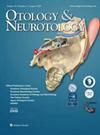咽鼓管内信号强度与耳科疾病临床特征的相关性
IF 1.9
3区 医学
Q3 CLINICAL NEUROLOGY
引用次数: 0
摘要
目的据报道,磁共振成像(MRI)显示的内淋巴管(ED)双侧高信号强度(SI)是大前庭导水管综合征(LVAS)患者耳朵的常见特征。然而,ED 双侧高 SI 的意义仍不清楚。本研究旨在比较 ED 中的 SI 与各种耳科疾病的临床表现之间的相关性,并考虑 MRI 发现的意义、主要结果测量将成像结果与临床症状进行比较。结果双侧内淋巴水肿 SIR 值较高的耳,其耳蜗和前庭的 EH 发生率往往大大低于双侧内淋巴水肿 SIR 值较低的耳。SIR≥8 的耳朵在纯音测听中的低频听阈明显升高,但其耳蜗 EH 的发生率明显低于 SIR<8 的耳朵。此外,有眩晕的耳朵的 SIR 明显高于无眩晕的耳朵。结论在 ED 中,MRI 上的双侧高 SI 可能反映了感音神经性听力损失和前庭症状的病理生理学基础,这与 EH 的形成无关。本文章由计算机程序翻译,如有差异,请以英文原文为准。
Correlation of Endolysmphatic Duct Signal Intensity With Clinical Features in Otological Diseases.
OBJECTIVE
Bilateral high signal intensity (SI) in the endolymphatic duct (ED) on magnetic resonance imaging (MRI) has been reported as a common characteristic in ears with large vestibular aqueduct syndrome (LVAS). However, the significance of bilateral high SI in the ED remains unknown. The present study aimed to compare the correlation between SI in the ED and the clinical manifestations in various otological disorders and consider the significance of the MRI findings.
STUDY DESIGN
Retrospective study.
SETTING
University hospital.
PATIENTS
The study included 2,450 ears from 1,225 patients with various otological disorders.
INTERVENTION
All ears underwent 3T enhanced MRI and were evaluated for the degree of endolymphatic hydrops (EH) and the SI ratios (SIRs; i.e., the calculation between SIs in the ED and those in the cerebellum).
MAIN OUTCOME MEASURE
The imaging findings were compared with their clinical symptoms.
RESULTS
Ears with bilateral high SIRs in the ED tended to have considerably less occurrence of EH in both the cochlea and vestibule than those with bilateral low SIRs. Ears with SIR ≥8 showed significantly elevated hearing thresholds at lower frequencies on pure-tone audiometry, although they exhibited a markedly lower incidence of cochlear EH than those with SIR <8. Moreover, ears with vertigo exhibited notably higher SIRs than those without vertigo.
CONCLUSION
Bilateral high SI in the ED on MRI may reflect pathophysiology underlying sensorineural hearing loss and vestibular symptoms, which are not associated with EH formation.
求助全文
通过发布文献求助,成功后即可免费获取论文全文。
去求助
来源期刊

Otology & Neurotology
医学-耳鼻喉科学
CiteScore
3.80
自引率
14.30%
发文量
509
审稿时长
3-6 weeks
期刊介绍:
Otology & Neurotology publishes original articles relating to both clinical and basic science aspects of otology, neurotology, and cranial base surgery. As the foremost journal in its field, it has become the favored place for publishing the best of new science relating to the human ear and its diseases. The broadly international character of its contributing authors, editorial board, and readership provides the Journal its decidedly global perspective.
 求助内容:
求助内容: 应助结果提醒方式:
应助结果提醒方式:


